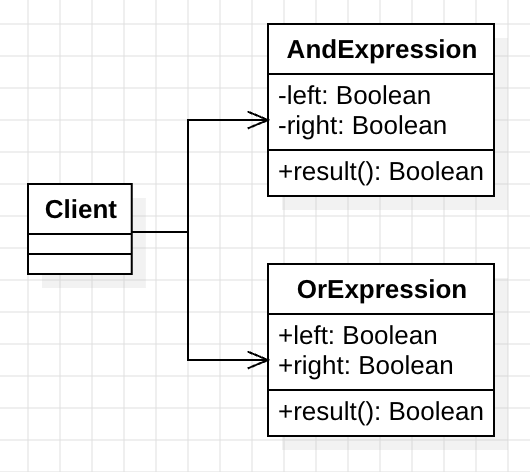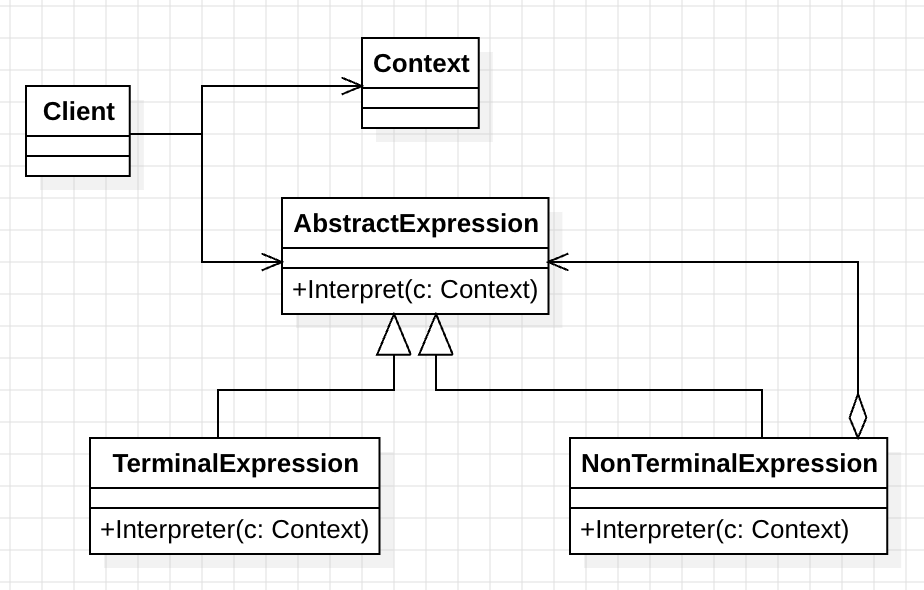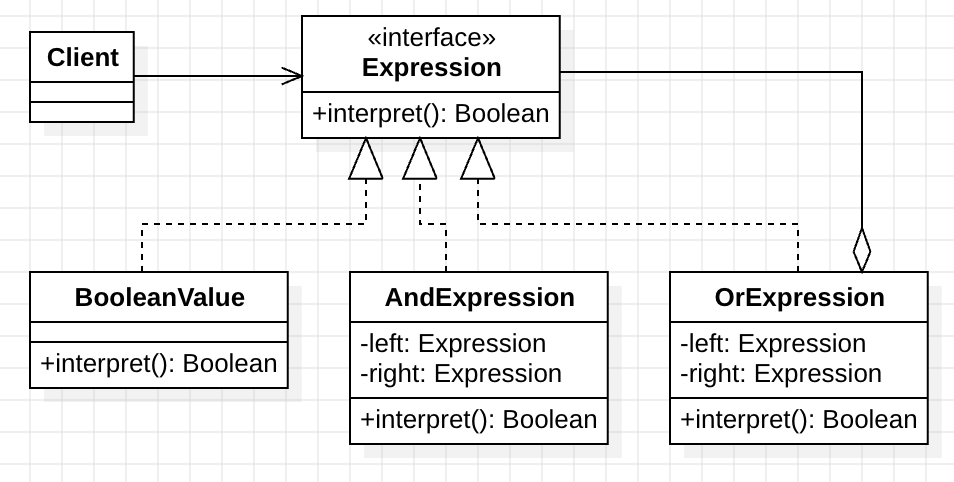Design Pattern 28: Interpreter Pattern - Complete Guide with Examples
📁 Download the complete Design Pattern series code from our design_pattern repository.
🎯 What is the Interpreter Pattern?
The Interpreter Pattern is a behavioral design pattern that defines a way to evaluate language grammar or expressions. It’s particularly useful for building interpreters for domain-specific languages (DSLs), expression evaluators, and rule engines.
Key Use Cases:
- ✅ Building expression evaluators
- ✅ Creating domain-specific languages
- ✅ Implementing rule engines
- ✅ Parsing mathematical expressions
- ✅ Processing configuration files
🚀 Real-World Problem: Boolean Expression Evaluator
Let’s build a boolean expression interpreter that can evaluate complex logical expressions like:
true AND false OR true(true OR false) AND trueNOT (false AND true)
Requirements:
- Evaluate boolean expressions with AND, OR, and NOT operators
- Support parentheses for grouping
- Follow the Open-Closed Principle for easy extension
- Maintain clear, maintainable code structure
🏗 Object-Oriented Analysis (OOA)
Let’s analyze the problem and identify the core components:

Identified Forces:
- Complexity Management
- Manual parsing logic becomes unmaintainable as operators increase
- Expression evaluation requires recursive processing
- Code Duplication
- Similar evaluation logic for different operators
- Repeated parsing code for different expression types
- Extension Challenges
- Adding new operators requires modifying existing code
- Violates the Open-Closed Principle
💡 Interpreter Pattern Solution
The Interpreter Pattern provides an elegant solution by representing each grammar rule as a separate class:

Core Components:
- Abstract Expression Interface
- Defines the common interface for all expressions
- Ensures uniform evaluation across different expression types
- Terminal Expressions
- Represent the basic elements (boolean values)
- Handle the simplest form of expressions
- Non-Terminal Expressions
- Represent complex operations (AND, OR, NOT)
- Recursively process sub-expressions
🛠 Implementation: Boolean Expression Interpreter
Here’s the complete implementation using the Interpreter Pattern:

1. Abstract Expression Interface
interface Expression {
fun interpret(): Boolean
}
2. Terminal Expression: Boolean Values
class BooleanValue(private val value: Boolean) : Expression {
override fun interpret(): Boolean = value
}
3. Non-Terminal Expressions: Logical Operators
class AndExpression(private val left: Expression, private val right: Expression) : Expression {
override fun interpret(): Boolean = left.interpret() && right.interpret()
}
class OrExpression(private val left: Expression, private val right: Expression) : Expression {
override fun interpret(): Boolean = left.interpret() || right.interpret()
}
class NotExpression(private val expression: Expression) : Expression {
override fun interpret(): Boolean = !expression.interpret()
}
4. Client Code: Building and Evaluating Expressions
fun main() {
// Build expression: true AND false OR true
val expression = OrExpression(
AndExpression(
BooleanValue(true),
BooleanValue(false)
),
BooleanValue(true)
)
// Evaluate the expression
val result = expression.interpret()
println("Expression: true AND false OR true")
println("Result: $result")
// Expected output: true
}
Output:
Expression: true AND false OR true
Result: true
🔧 Advanced Example: Expression Builder
Let’s create a more sophisticated expression builder:
class ExpressionBuilder {
fun buildComplexExpression(): Expression {
// Build: (true OR false) AND NOT false
return AndExpression(
OrExpression(
BooleanValue(true),
BooleanValue(false)
),
NotExpression(
BooleanValue(false)
)
)
}
}
// Usage
fun main() {
val builder = ExpressionBuilder()
val complexExpression = builder.buildComplexExpression()
println("Complex Expression: (true OR false) AND NOT false")
println("Result: ${complexExpression.interpret()}")
}
📊 Performance Considerations
| Aspect | Interpreter Pattern | Traditional Approach |
|---|---|---|
| Memory Usage | Higher (object overhead) | Lower |
| Execution Speed | Slower (method calls) | Faster |
| Maintainability | Excellent | Poor |
| Extensibility | Excellent | Difficult |
| Code Clarity | High | Low |
🎯 When to Use the Interpreter Pattern
✅ Perfect For:
- Domain-specific language implementation
- Expression evaluation systems
- Configuration file parsers
- Rule engines
- Mathematical expression evaluators
❌ Avoid When:
- Performance is critical
- Grammar is very complex
- Expressions are simple and rarely change
- Memory usage is a concern
🔗 Related Design Patterns
- Composite Pattern: Often used together for complex expression trees
- Visitor Pattern: For adding operations without modifying expression classes
- Strategy Pattern: For different evaluation strategies
- Factory Pattern: For creating expression objects
📚 Best Practices
1. Expression Tree Structure
- Keep expressions immutable
- Use composition over inheritance
- Implement proper error handling
2. Performance Optimization
- Consider caching for repeated expressions
- Use lazy evaluation when possible
- Profile memory usage for large expression trees
3. Extension Guidelines
- Follow the Open-Closed Principle
- Use factory methods for complex expression creation
- Document grammar rules clearly
🚨 Common Pitfalls
1. Infinite Recursion
// ❌ Avoid: Circular references
class CircularExpression : Expression {
private val self = this
override fun interpret(): Boolean = self.interpret()
}
2. Memory Leaks
// ❌ Avoid: Holding references unnecessarily
class BadExpression(private val heavyObject: HeavyObject) : Expression {
override fun interpret(): Boolean = true
}
3. Complex Grammar
- Keep grammar rules simple
- Consider using parser generators for complex languages
- Break down complex expressions into smaller parts
🔗 Related Articles
- Design Pattern 1: Object-Oriented Concepts
- Design Pattern 2: Design Principles
- Design Pattern 3: Introduction to Design Patterns
- Composite Pattern
- Visitor Pattern
✅ Conclusion
The Interpreter Pattern provides an elegant solution for building expression evaluators and language interpreters. By representing grammar rules as classes, we achieve:
Key Benefits:
- 🎯 Clear Structure: Each grammar rule is a separate class
- 🔧 Easy Extension: Add new operators without modifying existing code
- 📖 Maintainable Code: Well-organized, readable implementation
- 🚀 Flexible Design: Support complex expression evaluation
Remember: The Interpreter Pattern is perfect for domain-specific languages and expression evaluation, but consider performance implications for high-frequency operations.
💡 Pro Tip: Combine the Interpreter Pattern with the Visitor Pattern to add new operations without modifying expression classes.
🔔 Stay Updated: Follow our Design Pattern series for more software architecture insights!
Enjoy Reading This Article?
Here are some more articles you might like to read next: